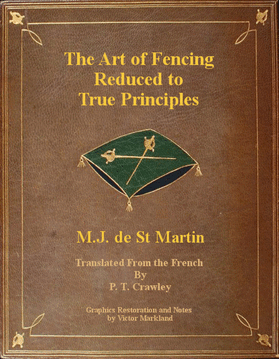The Art of the Smallsword by P.J.F. Girard
Translated by Philip Crawley with Kevin Côté
Paperback: 211 pages
• Publisher: Wyvern Media (October 13, 2014)
• ISBN-10: 0992991803
• ISBN-13: 978-0992991807
There have been in the last ten years only two or three really important republications of historic smallsword manuals in English. The first chronologically was Jared Kirby’s facsimile edition of Domenico Angelo’s School of Fencing. The second was Mark Rector’s Highland Swordsmanship which contained Donald McBanes’s Expert Swords-Man’s Companion and Sir William Hope’s New Method of Fencing. To this one might add the Royal Armories edition of John MacArthur’s Army and Navy Gentleman’s Companion; which sadly does not get the attention that it deserves. To that list we must now add another title, Philip Crawley’s translation of P.J.F. Girard’s The Art of the Smallsword.
Kirby’s Angelo, when it was published set the bar very high. The School of Fencing is a great manual. No one would argue otherwise. The text is clear and concise and the plates are worthy of study in their own right. Angelo rightly deserves, without exception, the attention of every smallsword student. In addition to being the most celebrated text in the English smallsword cannon this edition contained insightful notes by Maestro Jeanette Acosta-Martinez.
The influence of this edition was so powerful that a sort of organized Angelo orthodoxy arose. Its creed was that there was only one true smallsword master and that smallsword truth could only be accessed through his ordained high priests. Each subsequent publication after however served to chip away ever so slightly at the temple of Angelo. Now thanks to Mr. Crawley, Girard is available in English and the crack in the edifice runs to the core.
Girard presents us with a manual that takes a different point of view from Angelo, one that is enlightened by military and probably battlefield experience. As a result Girard’s emphasis, over all, is one of a more combative bend. He generally advocates very simple and conservative tactics and techniques. Let me give a couple of examples. He talks extensively about use of the off-hand. The unique “thumb-down and by-the-ear” position of the left hand really helps to put the arm in the ideal position to deflect thrusts at the body and more importantly, the head. Feints for Girard are nothing like a succession of nearly full-on attacks that we too often see in the salle but are generally done off of an appel. This is not in an attempt to psyche out the opponent but rather to combat the urge to, or necessity of, withdrawing the blade before the intended final thrust. Girard also covers a variety of “battlefield” or street fight scenarios. These include opposing spadroons, rapiers with and without and dagger; pikes, bayonets pitchforks and even flails.
Girard begins with the usual “How to mount a sword”. But soon after he teaches coming on guard as “Twelve Points to Consider Protecting Your Life”. This is indicative of his view to the primary purpose his tuition. Not “Avoid a touch” in the salle but “Go home alive” from an encounter with sharps. He goes on to describe the parades, attacks and the rest in very clear and concise terms. Typical for more combat oriented texts, like McArthur or even McBane , there is more use by Girard of tierce and low line attacks like seconde. Girard gives us advice on how to counter a variety of other so called “national” schools of sword play viz. Italian, Spanish, German. Also included are how to deal with a variety of other weapons and self defense situations. He finishes up with suggestions on how to teach Smallsword.
Mr. Crawley assisted by Kevin Côté has provided us with a very clear and fairly literal transition. The original was only altered where it was necessary to convey Girard’s meaning. But there is more here than just a translation of an important smallsword text. We also find introductory essays that place Girard in context, and provide background on the art of smallsword for the newcomer. This background serves to introduce some of the concepts that one would need to readily understand Girard’s instruction, and what kind of equipment will be required to begin. Mr. Crawley also provides a nice bit on what constitutes a curriculum and the necessity of having one in mind if one is to seriously study the sword arts. Finally we find several useful appendices which provide a brief “Cliff notes” summary of Girard’s method, and of special interest a table of critical measurements of original smallswords.
If pressed my only suggestions would be to add a table of contents and to make the plates larger, perhaps full page, even if it means printing them perpendicular to the text. To be fair the plates are available online for those who want to look at them in detail. This volume belongs in the collection of every student of smallsword. Mr. Crawley, the force behind the annual SmallSword Symposium in Edinburgh, has once again done us a great service and pushed forward the study of the art more than anyone else in the last few years. (Further proof: His translation of St Martin’s 1804 manual will be out soon too!) Go ye now and buy this book. (Or at least ask for it for Christmas.)

 RSS Feed
RSS Feed